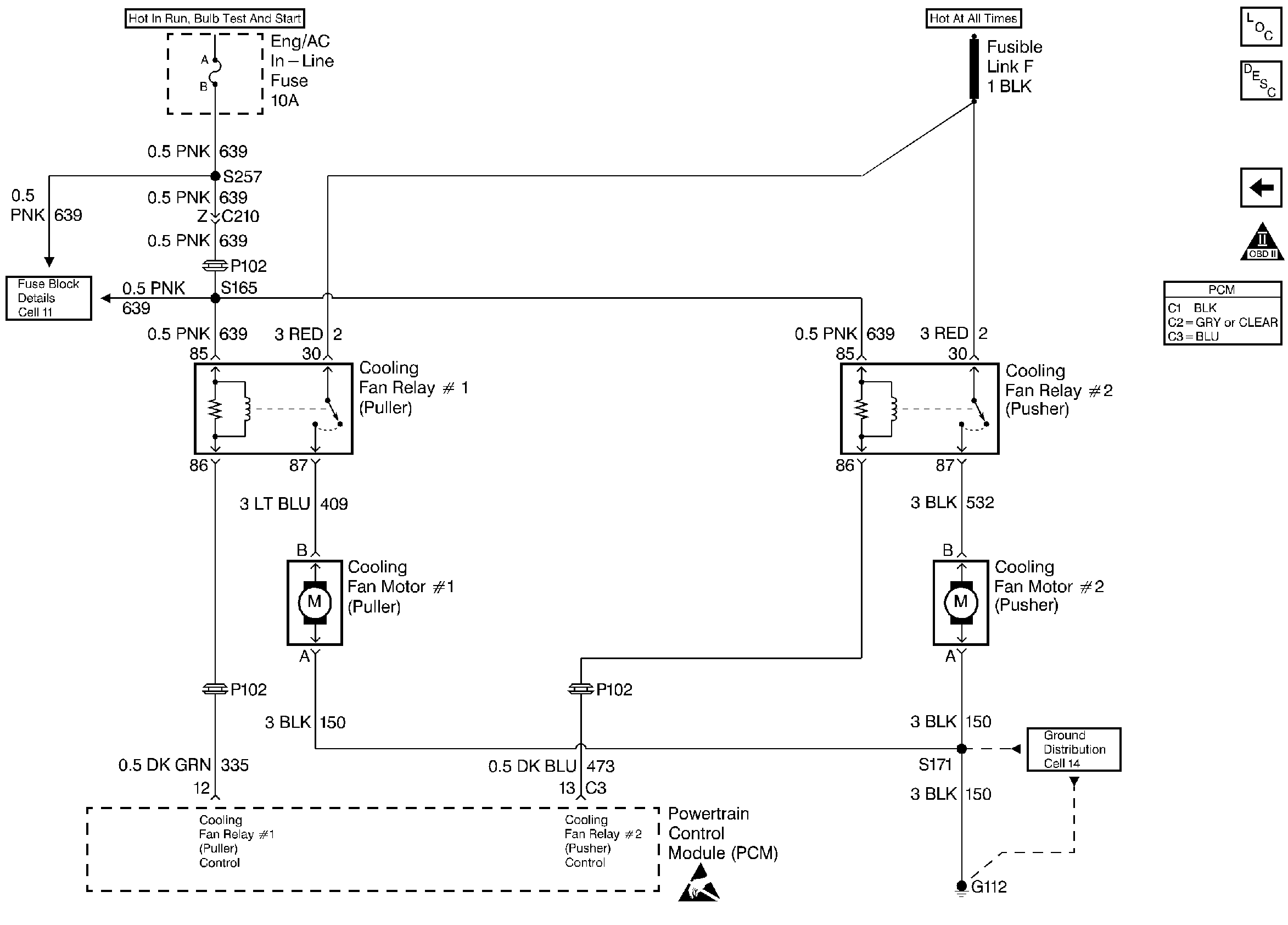Refer to
Cooling Fan Controls

Circuit Description:
The cooling fans are controlled by the PCM based on various inputs. Battery voltage is supplied to the primary and secondary cooling fan relays (switch side). Ignition voltage is supplied to the primary and secondary cooling fan relays (coil side). The PCM controls the cooling fan relays by providing a ground path.
The PCM will enable the engine cooling fans when certain Diagnostic Trouble Codes are set.
Diagnostic Aids
If the owner complained of an overheating problem, it must be determined if the complaint was due to an actual boil over, or the warning indicator light, or engine coolant temperature gage indicated overheating. The gage accuracy can also be checked by comparing the Engine Coolant Temperature (ECT) sensor reading using a scan tool and comparing its reading with the gage reading. If the engine is actually overheating and the gage indicated overheating, but the cooling fan is not coming ON, the Engine Coolant Temperature (ECT) sensor has probably shifted out of calibration and should be replaced.
If the engine is overheating and the cooling fans are ON, the cooling system should be checked, refer to Section 6B.
The PCM will command fan 1 ON at 108°C (226°F) and OFF at 100°C (212°F) and, fan 2 ON at 123°C (253°F) and OFF at 120°C (248°F).
Test Description
Number(s) below refer to number(s) on the diagnostic table.
-
The PCM will enable the engine cooling fans when certain Diagnostic Trouble Codes are set. Go to applicable DTC Table first before proceeding with this table.
-
Allow engine coolant temperature to cool below 100°C (223°F) before proceeding with diagnosis.
Step | Action | Value(s) | Yes | No |
|---|---|---|---|---|
1 | Was the Powertrain On-Board Diagnostic (OBD) System Check performed? | -- | ||
2 | Are any DTCs set? | -- | Go to applicable DTC Table | |
3 |
Are the cooling fans OFF? | 100°C (212°F) | ||
4 | Using a scan tool, command the cooling fan relay(s) ON. Are both cooling fans ON? | -- | ||
5 | With the engine idling, turn the A/C ON. Do the cooling fans turn ON when the A/C pressure reaches the specified value? | 200 psi | System OK | Go to |
6 | Disconnect the cooling fan relay for the cooling fan that is operating. Does the cooling fan stop? | -- | ||
7 |
Replace the cooling fan relay. Is the action complete? | -- | System OK | -- |
8 | Repair the circuit between the fan relay and the fan motor for a short to voltage. Is the action complete? | -- | System OK | -- |
9 |
Does the test light illuminate? | -- | ||
10 | Using a fused jumper wire, jumper the cooling fan relay electrical harness from the battery feed circuit to the circuit going to the fan motor (leave jumper installed for the remainder of the steps). Does the cooling fan operate? | -- | ||
11 |
Does the test light illuminate? | -- | ||
12 | Probe the cooling fan motor harness connector power feed circuit with a test light connected to ground. Does the test light illuminate? | -- | ||
13 | Check the connection at the fan motor harness connector. If a faulty connection is found, repair as necessary. Refer to Repair Procedures in Electrical Diagnosis (8A Cell 5). Was a problem found and corrected? | -- | System OK | |
14 | Repair open fan motor ground circuit. Refer to Repair Procedures in Electrical Diagnosis (8A Cell 5). Is the action complete? | -- | System OK | -- |
15 | Repair open power feed circuit between the fan relay and the cooling fan motor. Refer to Repair Procedures in Electrical Diagnosis (8A Cell 5). Is the action complete? | -- | System OK | -- |
16 | Repair open battery feed circuit to the fan relay. Refer to Repair Procedures in Electrical Diagnosis (8A Cell 5). Is the action complete? | -- | System OK | -- |
17 | Replace the cooling fan relay. Is the action complete? | -- | System OK | -- |
18 | Replace the cooling fan motor. Is the action complete? | -- | System OK | -- |
